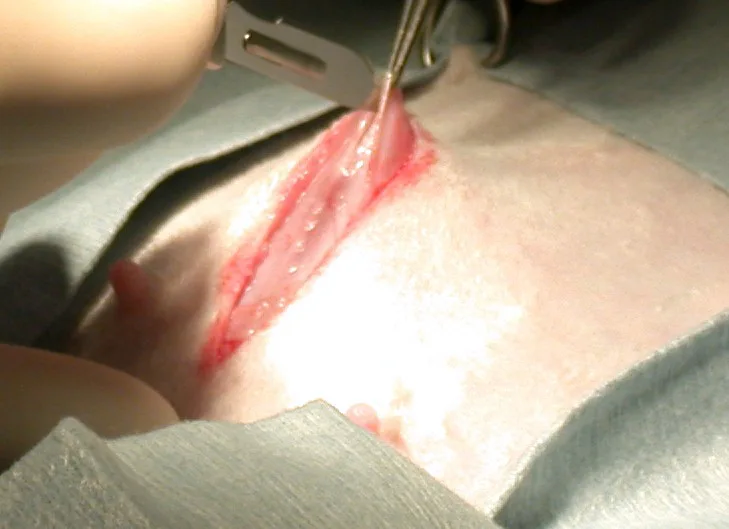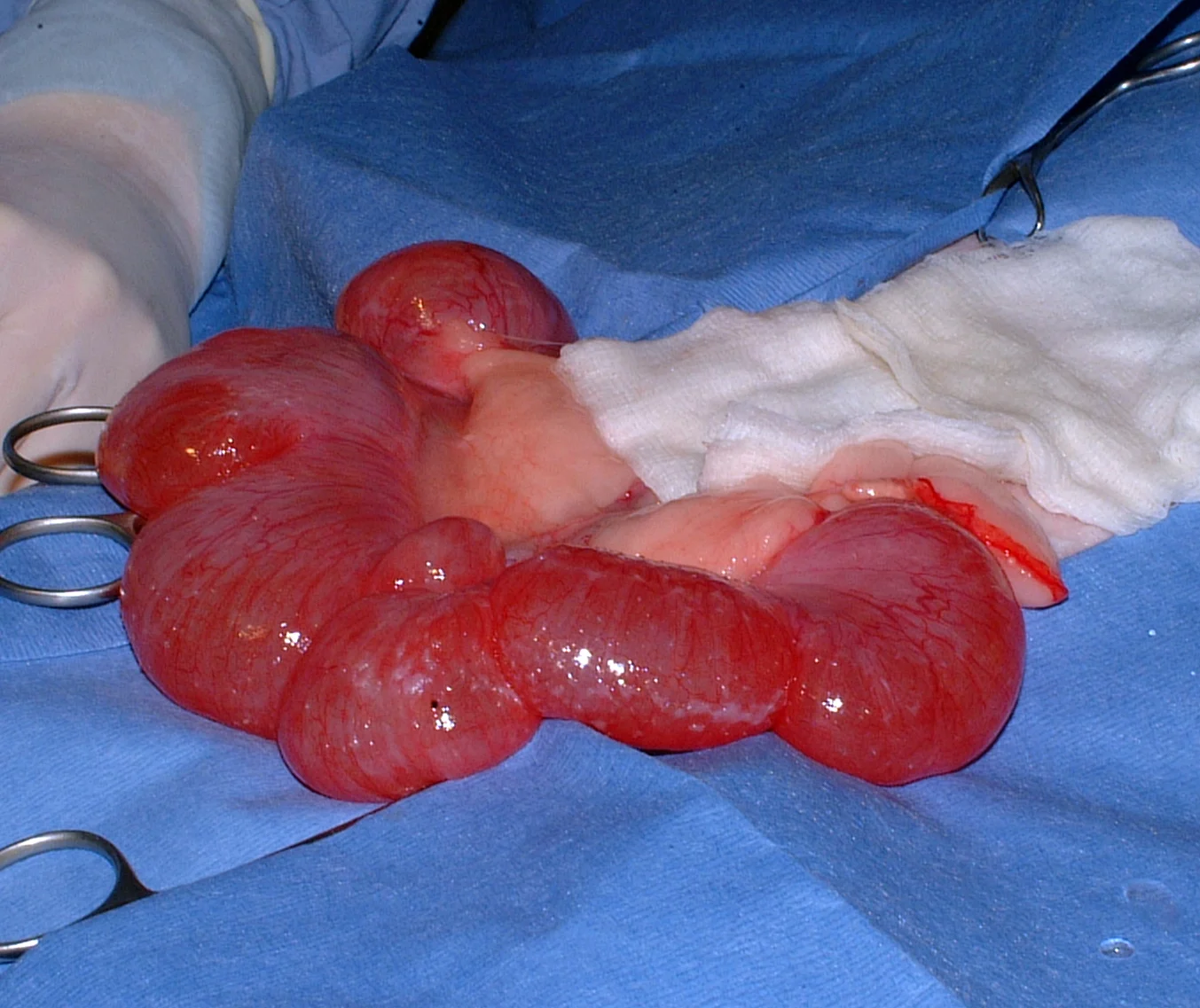Rabbit Ovariohysterectomy

With the popularity of rabbits as pets, more and more veterinarians are expected to perform elective neutering procedures. Female rabbits (does) have a propensity for uterine neoplasia if left intact, so ovariohysterectomy is recommended for nonbreeding does. If uterine neoplasia does occur (most frequently manifesting as bloody vaginal discharge, weight loss, and/or ileus), ovariohysterectomy is the treatment of choice. Spaying may also decrease territorial aggression, barbering, and undesirable urine-marking behaviors. Finally, spaying helps remove a rabbit from the breeding population, helping to combat the problem of overpopulation. Females are spayed between 4 and 6 months of age (sexual maturity), although spaying can be done early if certain anesthetic precautions are taken to prevent hypothermia and bradycardia/hypotension.
Step-by-Step: How to Perform an Ovariohysterectomy in Rabbits
Step 1
Position the anesthetized rabbit in dorsal recumbency with the legs tied loosely to the surgical table, as with dogs and cats. (Anesthesia of rabbits is beyond the scope of this article; refer to the references for more information). Although some clinicians choose to elevate the cranial half of the body several centimeters to allow for better ventilation in case the rabbit's heavy viscera pushes on the diaphragm, I have not found this to be necessary.
Clip the ventral abdomen using sharp clipper blades (rabbit skin tears easily if clipper blades are dull) from the xyphoid to 1 centimeter caudal to the pubis and laterally about halfway up each flank. Aseptically prepare the rabbit for surgery, and drape using your preferred aseptic method. I prefer to use a four-corner draping system (See Figure 2A).
Procedure Pearl
It is important to begin the incision just caudal to the umbilicus, as the intestinal viscera tend to lie just beneath this structure once the linea alba is incised.

Step 2
Make a ventral midline skin incision from 2 to 4 cm caudal to the umbilicus caudally to 2 to 3 cm cranial to the pubis. It is important to begin the incision just caudal to the umbilicus, as the intestinal viscera tend to lie just beneath this structure once the linea alba is incised. Rabbit skin is quite thin-minimal pressure on the scalpel blade is needed to incise the skin. If you are using electrocautery or laser, turn the setting down to about half of that used for a similar skin incision on a dog or cat. The subcutaneous tissue and fat are sharply dissected until the linea alba is visible. When entering the peritoneal cavity, take care to avoid perforating the cecum, which may be lying at the cranial aspect of the incision and slightly right of midline. If the cecum is perforated, the prognosis for recovery is grave due to septic peritonitis. Note that in the lower photograph the surgeon is lifting the abdominal musculature off the viscera before making a caudally facing puncture through the linea alba.


Step 3
Once the linea alba has been incised, the uterus is usually quite easy to locate ventrally in the peritoneal cavity. If it is not easily seen, simply find the bladder caudally, reflect it ventrally to locate the uterus, and trace this cranially. Do not use spay hooks in rabbits, as they can easily snare the delicate colonic or cecal tissue and lead to adhesions or septic peritonitis. Once the uterus is located, gently retract it out of the peritoneal cavity. The uterus shown is affected by adenocarcinoma with resulting hydrometra. The normal uterus is usually uniform in shape and size and similar in appearance grossly to a cat's uterus, with no assymetrical masses or hemorrhages on the serosal surface, as is seen with uterine adenocarcinoma.
Procedure Pearl
Do not use spay hooks in rabbits, as they can easily snare the delicate colonic or cecal tissue and lead to adhesions or septic peritonitis.

Related Article: How to Perform Venipuncture in Rabbits
Related Article: Cecal Perforation During Ovariohysterectomy in a Rabbit
Step 4
It is not necessary to break the ovarian suspensory ligament since the ovaries (pigmented in Figure 4A) are easily exteriorized. When exteriorized, the ovaries and their dorsal blood supply are easy to find because of the extensive retroperitoneal fat pad. The mesovarium, ovarian artery, and ovarian vein are located dorsal to the ovary. I prefer a triple-clamp method for ligature of the ovarian pedicle, but all practitioners have their own preference for safe and effective ligation of these vessels. I also prefer to double-ligate each ovarian stump (Figure 4B).
After ligation, sever and reflect the ovarian pedicle caudally and repeat the procedure for the other ovary. A size 2-0 to 4-0 monofilament absorbable suture should be used for ligation of the ovarian pedicle. Chromic catgut is contraindicated in rabbits because it causes an intense inflammatory reaction.


Step 5
Once the ovaries have been reflected caudally, the broad ligament should be easily seen. Rabbits store a large amount of fat in the broad ligament, so the fan-like uterine vasculature can be difficult to see (Figure 3). For this reason, I prefer to use electrocautery or laser to slowly and carefully cut the broad ligament, continuing to reflect the uterine horns caudally as I cut. Alternatively, several ligatures may be placed in the broad ligament to achieve hemostasis. The broad ligaments on each side should be cut to the level of the uterine arteries (these are clearly visible coursing cranially on the lateral aspect of the uterus in both broad ligaments).

Step 6
Reflect the uterus caudally so that the dorsal aspect of the vagina is visible. Plan to resect one third to one half of the vagina to completely remove uterine tissue. Note that some older references suggest ligating cranial to the cervices (rabbits have a bicornuate uterus); however, this technique leaves in cervical and uterine tissue that may become neoplastic in the future. (The dual cervices can be seen at the cranial extent of the vagina in Figure 5.) Further, the large vagina tends to pool urine and lead to urinary incontinence and urine scald. Ligate the uterine vessels separately (again using monofilament absorbable suture), proximal to the level of the planned vaginal resection.
Step 7
Double-ligate the vagina using 2-0 to 4-0 monofilament absorbable suture. The first ligature is a transfixation suture distal to the level of the uterine vessel ligatures, and the second is an encircling ligature just proximal to the transfixation. If the vagina is clamped, take care to avoid tearing this friable tissue. I tend to place one crushing clamp with a Kelly hemostat or Carmalt forceps in the area where my ligature will be.

Closing & Follow-Up
Examine both ovarian pedicles and the vaginal stump for hemorrhage. If none is present, close the linea alba. I prefer to close with a 2-0 to 4-0 monofilament absorbable suture in a simple continuous pattern to reduce surgical time. However, an interrupted pattern may be used as long as the rabbit is stable under anesthesia.
Close the subcutaneous tissue in one or two layers (depending on body condition) using 3-0 to 4-0 monofilament absorbable suture in a continuous mattress pattern. Rabbit ventral abdominal skin is very thin, so a dermal (subcuticular) layer is difficult to place but may be possible in some larger rabbits; in these cases, I use a 4-0 monofilament absorbable suture in a simple continuous pattern. In all rabbits, appose the skin using 3-0 nylon in a Ford-interlocking pattern (I prefer a continuous pattern in order to decrease surgical time).
Remove skin sutures 10 to 14 days after surgery. Monitor the patient for chewing at the suture line, although this is uncommon.